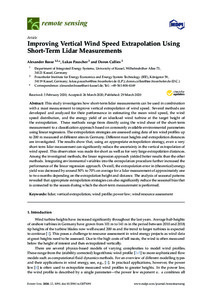Improving Vertical Wind Speed Extrapolation Using Short-Term Lidar Measurements
| dc.date.accessioned | 2020-04-15T12:17:43Z | |
| dc.date.available | 2020-04-15T12:17:43Z | |
| dc.date.issued | 2020-03-29 | |
| dc.identifier | doi:10.17170/kobra-202004021131 | |
| dc.identifier.uri | http://hdl.handle.net/123456789/11512 | |
| dc.description.sponsorship | Gefördert durch den Publikationsfonds der Universität Kassel | ger |
| dc.language.iso | eng | eng |
| dc.rights | Namensnennung - Weitergabe unter gleichen Bedingungen 4.0 International | * |
| dc.rights.uri | http://creativecommons.org/licenses/by-sa/4.0/ | * |
| dc.subject | lidar | eng |
| dc.subject | vertical extrapolation | eng |
| dc.subject | wind profile | eng |
| dc.subject | power law | eng |
| dc.subject | wind resource assessment | eng |
| dc.subject.ddc | 620 | |
| dc.title | Improving Vertical Wind Speed Extrapolation Using Short-Term Lidar Measurements | eng |
| dc.type | Aufsatz | |
| dcterms.abstract | This study investigates how short-term lidar measurements can be used in combination with a mast measurement to improve vertical extrapolation of wind speed. Several methods are developed and analyzed for their performance in estimating the mean wind speed, the wind speed distribution, and the energy yield of an idealized wind turbine at the target height of the extrapolation. These methods range from directly using the wind shear of the short-term measurement to a classification approach based on commonly available environmental parameters using linear regression. The extrapolation strategies are assessed using data of ten wind profiles up to 200 m measured at different sites in Germany. Different mast heights and extrapolation distances are investigated. The results show that, using an appropriate extrapolation strategy, even a very short-term lidar measurement can significantly reduce the uncertainty in the vertical extrapolation of wind speed. This observation was made for short as well as for very large extrapolation distances. Among the investigated methods, the linear regression approach yielded better results than the other methods. Integrating environmental variables into the extrapolation procedure further increased the performance of the linear regression approach. Overall, the extrapolation error in (theoretical) energy yield was decreased by around 50% to 70% on average for a lidar measurement of approximately one to two months depending on the extrapolation height and distance. The analysis of seasonal patterns revealed that appropriate extrapolation strategies can also significantly reduce the seasonal bias that is connected to the season during which the short-term measurement is performed. | eng |
| dcterms.accessRights | open access | |
| dcterms.creator | Basse, Alexander | |
| dcterms.creator | Pauscher, Lukas | |
| dcterms.creator | Callies, Doron | |
| dc.relation.doi | doi:10.3390/rs12071091 | |
| dc.type.version | publishedVersion | |
| dcterms.source.identifier | ISSN 2072-4292 | |
| dcterms.source.issue | Issue 7 | |
| dcterms.source.journal | Remote sensing | eng |
| dcterms.source.pageinfo | 1091 | |
| dcterms.source.volume | Volume 12 | |
| kup.iskup | false |
Dateien zu dieser Ressource
Das Dokument erscheint in:
-
Artikel [1104]


